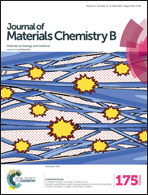Regeneration of hyaline-like cartilage and subchondral bone simultaneously by poly(l-glutamic acid) based osteochondral scaffolds with induced autologous adipose derived stem cells
Abstract
Osteochondral tissue engineering is challenged by the difficulty in the regeneration of hyaline cartilage and the simultaneous regeneration of subchondral bone. In the present study, nhydroxyapatite-graft-poly(L-glutamic acid) (nHA-g-PLGA) was prepared by surface-initiated ring-opening polymerization, which was then used to fabricate an osteogenic scaffold (scaffold O) instead of nHA to achieve better mechanical performance. Then, a single osteochondral scaffold was fabricated by combining the poly(L-glutamic acid) (PLGA)/chitosan (CS) amide bonded hydrogel and the PLGA/CS/nHA-g-PLGA polyelectrolyte complex (PEC), possessing two different regions to support both hyaline cartilage and underlying bone regeneration, respectively. Autologous adipose derived stem cells (ASCs) were seeded into the osteochondral scaffold. The chondrogenesis of ASCs in the scaffold was triggered in vitro by TGF-β1 and IGF-1 for 7 days. In vitro, a chondrogenic scaffold (scaffold C) exhibited the ability to drive adipose derived stem cell (ASC) aggregates to form multicellular spheroids with a diameter of 80–110 μm in situ, thus promoting the chondrogenesis while limiting COL I deposition when compared to ASCs adhered in scaffold O. Scaffold O showed the ability to bind abundant BMP-2. Osteochondral scaffolds with induced ASC spheroids in scaffold C and bonded BMP-2 in scaffold O were transplanted into rabbit osteochondral defects as group I for in vivo regeneration. At the same time, osteochondral scaffolds with only bonded BMP-2 in scaffold O and bare osteochondral scaffolds were filled into rabbit osteochondral defects to serve as group II and group III, respectively. After 12 weeks post-implantation, cartilage and subchondral bone tissues were both regenerated with the support of induced ASC spheroids and bonded BMP-2 in group I. However, in group II, cartilage was not repaired while subchondral bone was regenerated. In group III, the regeneration of both cartilage and subchondral bone was limited.


 Please wait while we load your content...
Please wait while we load your content...